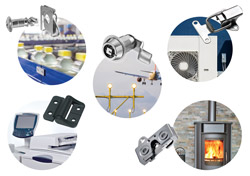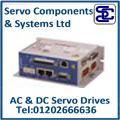
Posted to News on 26th Jun 2017, 14:19
Five ways to future-proof industrial products
David Kelly, Regional Product Manager at Southco presents five concepts that manufacturers need to embrace when future-proofing industrial products and applications in order to ensure long-term success.

Globalisation, new technologies and evolving customer preferences have increased pressure on manufacturing businesses worldwide to develop better quality products, with more distinctive features, at a competitive price and born out of cutting-edge technology. Such complex market dynamics present manufacturing businesses with the challenge of successfully fulfilling these demands while at the same time they provide the opportunity for differentiation, market leadership and ultimately business growth.
This report discusses how, regardless of industry or product, manufacturing businesses can adopt transferable principles to help safeguard against industrial challenges and remain competitive.
1. Competing through differentiated design
Differentiation through industrial design is no longer a product development feature exclusive to high-end industries. Whether you manufacture industrial equipment, heating, ventilation and air conditioning (HVAC) products or luxury furniture, the end-user will evaluate the quality and value of your product through its design.
As markets become more volatile, more intuitive and streamlined equipment design can provide a greater competitive advantage. And although aesthetics and ergonomics may not naturally stand out as key design considerations for developing industrial equipment, they strongly influence hardware selection, David Kelly explains: "We regularly discuss industrial design challenges with our customers and how to address these to stay competitive. The look and feel of industrial equipment, although placed in very rugged settings, is still very important to them. So we encourage product designers to consider engineered access hardware - that is locks, latches, mounts and hinges - as a source of differentiation.
"Often these components are the vital touch points the end user interacts with. For example, using a position control hinge on an industrial machine's screen display mount offers significant ergonomic benefits that generate a perception of added value with the end-user: smoother user operation, no screen drift or manual effort. Our customers choose position control hinges and display mounts to improve the usability of factory equipment, medical devices and lighting applications."
2. Addressing safety and security risks
Failure to comply with safety regulations can make or break a product's market success. At the same time, as customer demands and technology advancements increase, a product's time-to-market is expected to decrease considerably, putting pressure on operations departments to improve productivity on the one hand and be health and safety compliant on the other. Care must be taken to ensure that the pressure to respond quickly to changing market conditions does not compromise the safety and security of industrial machinery and equipment. David Kelly elaborates: "Addressing operational safety and security is vital to the future of industrial equipment manufacturers. The incremental downtime caused by day-to-day challenges such as loss of hardware and assembly of complex parts can mean the difference between a company leading in its market or being left behind.
"To allay concerns surrounding industry compliance, risks can be addressed by selecting hardware which not only complies with industry standards but actively enhances the safety and performance of machinery and equipment. At the very least, machine manufacturers need to align their hardware to standards such as the Machinery Directive (Machinery Directive 2006/42/EC) which stipulates that hardware used on machine guards and panels should be captive to the machine, to safeguard against lost or ingested parts.
"When designing such applications, machinery manufacturers should design-in captive quarter-turn fasteners for example, maximising the safety of the operator and the uptime of the machine itself."
3. Improving efficiency and consistency
As Forbes' 2016 study highlights, the primary driver for manufacturing businesses in 2017 is to lower their cost of operation. This is undoubtedly in response to the increased amount of global competition in the market and consumer demands for competitively priced goods. No other industry is as exposed to global cost competition as much as manufacturing, so manufacturers are constantly looking for new ways to enhance efficiency through the adoption of new technologies, products and processes.
David Kelly comments: "Industrial application manufacturers are investing more in hardware designed with fewer components. At Southco, we identified a main value point for our manufacturing customers to gain assembly efficiencies by using, for example, fixed-grip and pre-set compression latches. With less parts of the latch to assemble and compression pre-set by Southco, customers were able to take time and cost out of the assembly process."
By selecting parts that help to drive up efficiency and consistency in this way, companies are able to stay competitive and in control. An established hardware supplier will also deploy significant tests and procedures to ensure hardware longevity and uniformity of the finished part, irrespective of volume.
4. Boosting performance
Products with durability and high performance will be the ones that stand the test of time. Hardware products should be selected to enhance the overall performance of an application. Choosing hardware that can perform consistently regardless of weather, temperature or pressure variances will ultimately enhance the longevity of an industrial application.
David Kelly says: "We are often asked to recommend materials and finishes to optimise an application's performance. For example, our miniature stainless steel draw latch is chosen to provide consistent clamping force for maximum sealing on covers and panels in outdoor applications, ensuring a durable solution and performance for the entire application. With various IP ratings available we help customers to think not only about the initial cost of the solution but increasingly about product longevity and application quality through their hardware selection."
How manufacturers and engineers test for and assure quality and performance is another key indicator in the future success of a product or application. A proven supplier should have manufacturing, testing and assembly processes in place that provide a high level of product integrity - even in the most demanding application environments. Working with them to choose the most suitable hardware option for your unique application could be a key factor in your differentiation.
5. Enhancing flexibility
In the next decade, production is likely to become more customer-tailored, with each individual project boasting a unique set of design challenges. Manufacturers are challenged to meet these bespoke demands. How can product manufacturers and designers fulfil complex design briefs while ensuring that their products remain competitive, flexible and user-friendly?
As mentioned in the Manufacturing Our Future report (McKinsey Global Institute, 2012) manufacturing businesses should become more service driven to help meet growing customer demands for increased value.
David Kelly recommends: "Look for a provider who can offer flexibility and innovation. Working alongside manufacturers and engineers and adapting a partnership approach can drive innovation as well as solutions, offering you a service, not just a product. For example, our engineering teams have worked alongside domestic application designers to identify a rotary latch system for best securing the main door on their domestic fire and heating products. The offer of a concealed, push-to-close latch has made the fire design more sleek and safe, and the easy push-to-close function enhances usability. Manufacturers have seen significant steps forward in addressing their industrial design challenges by incorporating concealed latch and actuation options."
Change ahead
Finding the answers to tough industrial design challenges will enable manufacturers to enhance their competitive design advantage, increase assembly efficiencies and maximise application safety and performance. This can be achieved in an affordable and realistic manner through making the right choices, for example, as this article has discussed, in selecting appropriate hardware components. Manufacturers can then successfully meet their operational goals while responding to the market challenges and opportunities that lie ahead. By assessing existing processes and enhancing them with higher performing component parts, they can also drive up efficiency at a lower cost. Even the choice to source multiple parts from one supplier instead of many can provide cost and efficiency benefits. David Kelly concludes: "In the future, there will be a host of new challenges and opportunities for general industry designers and manufacturers. More sophisticated engineered hardware can help them resolve key problems around design differentiation, safety, efficiency, performance and flexibility."
Follow the link for more information about the products and services available from Southco.
Want the latest machine building news straight to your inbox? Become a MachineBuilding member for free today >>


















